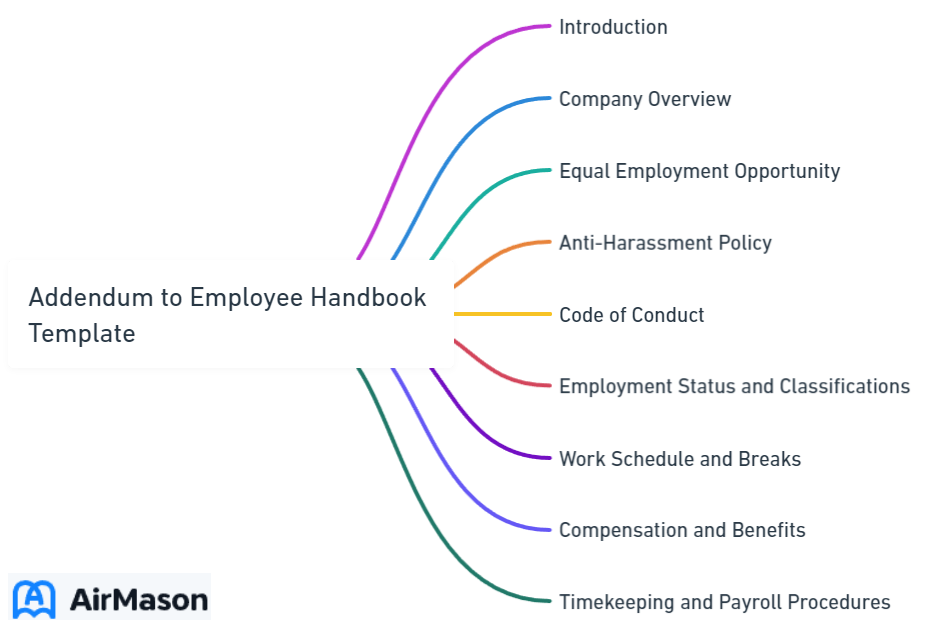
An addendum to an employee handbook serves as an important tool for organizations to communicate updates, changes, or additions to their existing policies and procedures. It ensures that employees are aware of the revised guidelines and provides clarity on any new policies that may have been implemented.
In this article, we will explore the purpose and key components of an addendum to an employee handbook, as well as the steps involved in creating one. We will highlight the best practices that organizations should follow to effectively implement addendums and maintain compliance with employment laws.
By understanding the importance and following the proper procedures, organizations can ensure that their employees are well-informed and that their employee handbooks remain up-to-date and relevant.
What is an Addendum to an Employee Handbook?
An addendum to an employee handbook is an extra document that updates, revises, or adds new policies to the existing handbook. It ensures clear communication, legal compliance, transparency, contextual relevance, and flexibility. By clearly outlining changes or additions, an addendum helps employees understand the purpose and rationale behind the updates, facilitating a smoother transition. Overall, an addendum to an employee handbook is a crucial tool in keeping the handbook up-to-date and relevant to current policies and practices, while allowing for adaptation to changing business needs.

Why is an Addendum Needed for an Employee Handbook?
An addendum is necessary for an employee handbook for several important reasons. It allows for updates and changes without rewriting the entire document, ensuring the handbook stays current and relevant to the organization and its employees.
An addendum provides clarification and extra information on specific policies or procedures that may be complex or require further explanation. Moreover, an addendum can address legal or regulatory changes that may impact the policies outlined in the employee handbook.
By incorporating these changes through an addendum, the organization can ensure compliance without recreating the entire handbook. Additionally, an addendum offers flexibility in tailoring the employee handbook to specific departments or roles within the organization.
Different departments may have unique policies or procedures that need separate attention, and an addendum allows for this customization while maintaining consistency throughout the handbook. Therefore, incorporating an addendum into an employee handbook serves multiple purposes and provides numerous benefits for both the organization and its employees.

Key Components of an Addendum to an Employee Handbook
When it comes to creating an addendum to an employee handbook, understanding the key components is essential. In this section, we’ll dive into the purpose of the addendum, its effective date, scope and applicability, changes to existing policies, new policies or procedures, and the significance of the addendum. Get ready to explore the crucial elements that shape an addendum and its impact on the employee handbook. So, let’s unravel the intricacies and importance of these components!
Purpose of the Addendum
The purpose of an addendum to an employee handbook is to communicate changes or additions to policies or introduce new policies and procedures. It updates and informs employees about important information that may affect their work or employment.
The addendum clarifies and ensures that all employees are aware of any modifications or enhancements to the company’s policies. It helps maintain consistency and compliance with employment laws, ensuring that the organization is up-to-date with any legal requirements that may impact the workplace.
Additionally, the addendum establishes a record of changes made to the employee handbook, which can be useful for future reference or legal purposes. It also reminds employees of their responsibilities and rights within the organization.
To create an addendum, it is important to determine the purpose of the addendum, identify specific modifications or additions, and draft the content of the addendum. It is crucial to review the addendum with legal or HR experts to ensure compliance with applicable laws and regulations. Communication with employees and obtaining their acknowledgment of the changes is necessary.
Fact: Approximately 59% of companies have updated their employee handbooks in the past two years to address new workplace trends and legal requirements.
Effective Date of the Addendum
The effective date of the addendum is crucial and must be clearly stated and understood by all employees. This date determines when the changes or additions outlined in the addendum will take effect. Consistency and accuracy are important in determining the effective date, as it ensures employees are aware of when the new policies or procedures will be implemented.
To determine the effective date of the addendum, the employer should consider various factors. These factors may include the need for sufficient time to communicate the changes to employees, train managers and supervisors on the new policies, and allow employees to review and ask questions about the modifications.
It is recommended to consult with legal or HR experts to ensure compliance with employment laws and regulations regarding the effective date of the addendum. This ensures the company is adhering to all legal requirements and mitigating any potential legal risks.
Once the effective date of the addendum is determined, it is important to communicate it clearly to employees. This can be done through company-wide announcements, email notifications, or by including the information in the employee handbook itself. Obtaining employee acknowledgment of the addendum and its effective date further ensures everyone is aware of the changes and complies with them.
By establishing a clear and well-defined effective date of the addendum, companies can effectively implement new policies and procedures while providing employees with the necessary time and information to adapt.
Scope and Applicability
The scope and applicability of an addendum are crucial factors to consider when developing an employee handbook. This table thoroughly analyzes the key details:
| Scope: | The addendum’s scope involves precisely defining the specific areas or departments to which it applies. This may encompass alterations or additions to policies, procedures, or guidelines that directly impact these areas. |
Applicability: Identifying the employees affected by the addendum is essential. This can encompass all employees, specific job roles, or a particular division within the company.
By outlining the scope of the addendum, its influence becomes evident, and employees become aware of the pertinent policies and procedures. This fosters clarity, consistency, and accountability within the organization.
The applicability of the addendum determines which employees must comply with the new or revised policies. It ensures that the content is relevant to designated individuals or departments.
Precisely defining both the scope and applicability aids organizations in implementing changes, addressing concerns, and complying with employment laws. Maintaining concise and easily understandable language is a suggestion. Seek legal or HR expert advice when drafting the addendum to guarantee compliance with laws and regulations. Regular communication, training, and feedback are crucial for ensuring the effectiveness of the addendum.
Changes to Existing Policies
When making changes to existing policies in an employee handbook, several important considerations should be taken into account. These include clearly communicating the purpose and rationale behind the policy change, defining the extent of the change, ensuring consistency with existing policies, setting a clear timeline for implementation, and encouraging employee feedback and addressing their concerns. By following a structured approach and considering these factors, policy changes can be effectively implemented and employees can understand and comply with the updated guidelines.
New Policies or Procedures
When creating an employee handbook addendum, it is important to consider new policies or procedures. Here are some key points to keep in mind:
- Identify the need: It is crucial to determine why new policies or procedures are necessary due to legislative or industry changes.
- Research and analyze: Conducting thorough research for best practices and considering the impact on employees and the organization is essential.
- Draft the content: Use clear and concise language to outline expectations, responsibilities, and consequences in the addendum.
- Review and consult: Seeking input from legal or HR experts to ensure alignment with laws and regulations is recommended.
- Communicate and train: Effectively communicating policies or procedures to all employees and providing training for understanding and compliance is crucial.
- Obtain acknowledgment: It is advisable to ask employees to acknowledge their understanding and acceptance of the new policies or procedures through signed forms or electronic systems.
One company, ABC Corporation, implemented new policies focused on remote work and flexible schedules. The addendum included guidelines for remote work expectations, communication protocols, and performance measurement. These new policies or procedures had a positive impact on morale and job satisfaction among employees, creating a supportive work environment. ABC Corporation regularly reviewed and updated policies to adapt to evolving circumstances.
Significance of the Addendum
The significance of the addendum to an employee handbook is its ability to provide clarity, transparency, and legal protection for the employer and employees. Key points to consider include:
1. Enhances understanding: The addendum clarifies changes or additions to the handbook’s existing policies and procedures. It ensures all employees are aware of updates and understand their rights and responsibilities.
2. Mitigates legal risks: The addendum includes any necessary legal updates for compliance with employment laws. This reduces the risk of potential legal issues and protects both the company and employees from disputes.
3. Maintains consistency: The addendum ensures alignment between the handbook and any new policies or procedures. It keeps employees informed and ensures the organization’s practices align with its policies.
4. Provides reference documentation: The addendum serves as a document for employees to easily access and review changes or additions to the handbook. It avoids confusion and provides necessary information.
5. Employee acknowledgment: By obtaining employee acknowledgment of the addendum, the organization demonstrates that employees have been informed of the changes and understand their implications. This provides additional legal protection.

How to Create an Addendum to an Employee Handbook?
In this section, we’ll dive into the process of creating an addendum to an employee handbook. From recognizing the need for an addendum to drafting the content and seeking legal or HR expertise, we’ll cover all the essential steps. We’ll also explore the importance of effectively communicating the changes to employees and obtaining their acknowledgment. So, if you’re looking to update your employee handbook with new policies or modifications, this guide will provide you with the necessary insights to create a comprehensive addendum.
Determine the Need for an Addendum
To determine the need for an addendum for an employee handbook, organizations should take into account changes in legislation, updates in company policies, and employee feedback. Changes in legislation may require updates to ensure that company policies align with legal requirements. If there are significant shifts in objectives, practices, or procedures related to company policies, adding an addendum may be necessary.
Additionally, employee feedback and concerns can highlight areas where the handbook may be unclear or outdated, which may prompt the need for an addendum. Regularly assessing these factors helps to ensure that the handbook remains relevant. By considering changes in legislation, company policies, and employee feedback, organizations can determine when it is necessary to provide clear communication and guidance through an addendum.
Identify the Changes or Additions
To effectively identify the changes or additions in an addendum to an employee handbook, it is important to carefully review and analyze the existing policies and procedures. Here is a table that summarizes the process of incorporating these changes:
| Step | Instructions |
|---|---|
| 1 | Gather the current employee handbook and relevant documents. |
| 2 | Compare the existing policies and procedures with recent updates or changes in employment laws. |
| 3 | Identify the areas where the existing policies require revision or where new policies need to be added. |
| 4 | Take into consideration the feedback and suggestions provided by employees, managers, and legal or HR experts. |
| 5 | Determine the specific changes or additions that are necessary to address the identified gaps or issues. |
| 6 | Use clear and concise language to create the changes or additions, ensuring that they align with the company’s values and goals. |
| 7 | Incorporate these changes or additions into the addendum, clearly stating the section or policy that is being modified or added. |
| 8 | Review the addendum for accuracy, consistency, and compliance with employment laws. |
| 9 | Obtain legal or HR approval for the addendum. |
| 10 | Communicate the changes or additions to employees and ensure that they acknowledge them. |
By following these steps, organizations can effectively identify and address the necessary changes or additions to their employee handbooks, thereby ensuring compliance, clarity, and consistency throughout the organization.
Draft the Addendum Content
When drafting the addendum content for an employee handbook, it is important to follow a systematic approach for clarity and completeness. Here are the steps to consider:
1. Review existing policies: Thoroughly review the current employee handbook to identify policies or procedures that need to be addressed in the addendum.
2. Identify changes or additions: Clearly and concisely identify the changes or additions included in the addendum. State the purpose and significance of these changes in a factual manner. These changes can be any thing for example adding pictures in employee handbook or adding new policies.
3. Provide detailed explanations: Comprehensively explain each policy or procedure included in the addendum. Use specific language and avoid ambiguous or subjective statements.
4. Include specific dates and effective timeline: Specify the addendum’s effective date and any specific timelines for implementing the changes.
5. Clearly outline scope and applicability: Define the addendum’s scope and specify affected employees or departments. Be precise and avoid vague statements.
6. Adhere to legal and HR guidelines: Consult legal or HR experts to ensure compliance with employment laws and regulations. Seek guidance on any necessary language or requirements.
7. Communicate effectively: Once the addendum content is drafted, communicate the changes to all employees. Obtain employee acknowledgment, either through signatures or electronic confirmation, to ensure awareness and understanding.
By following these steps and maintaining clarity and consistency throughout the drafting process, you can create a comprehensive and effective addendum to an employee handbook.
Review and Consult with Legal or HR Experts
Consulting with legal or HR experts is crucial when creating an addendum to an employee handbook. It is important to review and consult with these experts as they possess a deep understanding of employment laws and can offer valuable guidance and insights. They have the expertise to carefully review proposed changes or additions in the addendum and evaluate potential legal implications. This collaborative process helps identify necessary adjustments for compliance.
Involving experts in the drafting and implementation of the addendum can also aid in clarifying complex legal terminologies and ensuring clear language in the document. By seeking their advice and input regularly, potential issues can be proactively addressed, ultimately saving time and resources.
To ensure compliance and effectively address any changes or additions to the employee handbook, it is recommended to maintain open communication with legal or HR experts throughout the entire process. Regularly consulting with them and seeking their advice will help ensure that the addendum aligns with legal requirements and best practices.
Communicate and Obtain Employee Acknowledgment
When creating an addendum to an employee handbook, it is important to communicate and obtain employee acknowledgment. Follow these steps for effective communication and acknowledgment:
1. Clearly explain the purpose and content of the addendum to employees.
2. Share the addendum with employees through an official communication channel such as email or a company-wide memo.
3. Provide sufficient time for employees to review the addendum.
4. Encourage employees to ask questions or seek clarification if needed.
5. Require employees to acknowledge receipt and understanding of the addendum.
6. Implement a system to track employee acknowledgments, such as requiring a signed acknowledgment form or using a digital acknowledgment platform.
Obtaining employee acknowledgment is crucial for ensuring compliance and understanding of the updated policies or procedures outlined in the addendum. By actively communicating and obtaining acknowledgment, employers can promote transparency, accountability, and a shared understanding of the changes.

Best Practices for Implementing Addendums to Employee Handbooks
When it comes to implementing addendums to employee handbooks, there are some key best practices to keep in mind. From maintaining clarity and consistency to ensuring compliance with employment laws, documenting changes, training managers and supervisors, and seeking feedback, this section dives into the essential strategies for a successful implementation. So, let’s explore these practices and discover how they can enhance the effectiveness and efficiency of your employee handbook addendums.
Maintain Clarity and Consistency
Maintaining clarity and consistency in an employee handbook addendum is crucial for several important factors. To achieve this, it is essential to incorporate the following guidelines:
1. Use clear language: Present the information in the addendum straightforwardly and understandably, avoiding confusing jargon or technical terms.
2. Follow a consistent format: Ensure a consistent structure and layout, including headings, subheadings, bullet points, and numbering. This will facilitate employee navigation and help them locate information easily.
3. Align with existing policies: It is important to ensure that the addendum is consistent with the organization’s current policies. Use the same terminology and ensure that any updates or changes align with the overall objectives.
4. Provide examples and explanations: Accompany new policies or amendments with examples and explanations. This will help clarify their application in employees’ daily work.
5. Communicate clearly: Clearly instruct employees on necessary actions, such as signing an acknowledgment form or attending a training session when sharing the addendum. Utilize multiple communication channels to ensure all employees receive the information.
6. Regularly review and update: It is crucial to regularly review and update the addendum to maintain accuracy and relevance as rules and regulations change. This will uphold clarity and consistency in the employee handbook.
In a recent real-life example, a company introduced a new dress code policy through an addendum to their employee handbook. To maintain clarity and consistency, they provided clear guidelines for appropriate attire in various work settings. They also included visual examples to illustrate acceptable and unacceptable clothing choices. The company communicated the addendum through a company-wide email and an all-staff meeting presentation. Employees were required to sign an acknowledgment form to confirm their understanding of the new policy. By maintaining clarity and consistency in the addendum, the company ensured that employees comprehended the expectations and could adhere to the new dress code guidelines.
Ensure Compliance with Employment Laws
To ensure compliance with employment laws, organizations must diligently follow guidelines and regulations. It is crucial to stay updated with employment laws at all levels, including local, state, and federal, by regularly monitoring and staying informed about any changes. This includes laws related to hiring, discrimination, minimum wage, employee benefits, and workplace safety.
To align with current employment laws, organizations should regularly review and revise their company policies. It is important to make necessary revisions to address any changes in legislation, such as updating anti-discrimination policies or adjusting leave policies to comply with new family and medical leave regulations.
Thorough training sessions should be conducted to educate employees and managers about employment laws, their rights, and responsibilities. This can prevent violations and ensure that everyone is aware of their legal obligations.
Maintaining accurate records is essential. Organizations should keep detailed records of employee contracts, time and attendance, payroll information, and performance evaluations. This documentation serves as evidence of compliance and provides protection against any potential legal disputes.
To stay proactive, organizations should continuously monitor for potential risks or violations of employment laws. Regularly assessing practices to comply with changing regulations is imperative. Seeking legal advice or consulting HR experts when needed is crucial to address any concerns that arise.
Creating a culture of compliance within the organization is a pro-tip. This can be achieved by promoting open communication, providing regular training, and conducting internal audits to ensure ongoing compliance with employment laws.
Document Changes and Retain Records
When updating an employee handbook, it is crucial to document and retain records of the changes. Follow these steps:
1. Identify the changes or additions: Determine the specific policies, procedures, or provisions that need modification or addition.
2. Update the addendum content: Draft the new policies or changes in a clear and concise manner that employees can easily understand.
3. Create a record of changes: Keep a detailed record of the modifications, including the date, the affected section of the handbook, and the rationale behind the change.
4. Include supporting documentation: Attach relevant materials such as legal guidelines that justify the need for the changes.
5. Seek review and consultation: Get input from legal or HR experts to ensure compliance with employment laws.
6. Obtain employee acknowledgment: Communicate the changes to employees and require them to acknowledge receipt and understanding, using signed forms or electronic consent.
7. Retain records: Store copies of the addendum, employee acknowledgments, and supporting documentation in a secure and easily accessible location for future reference or audits.
By following these steps and documenting changes, companies can maintain transparency, clarity, and compliance in their employee handbooks.
Train Managers and Supervisors
When incorporating an addendum to an employee handbook, it is crucial to effectively train managers and supervisors. Managers and supervisors need a clear understanding of the changes and additions in the addendum, so they can communicate and enforce them with their teams properly. Here are some important considerations for training managers and supervisors:
1. Conduct training sessions: Organize dedicated training sessions specifically for managers and supervisors. This will acquaint them with the content of the addendum. Training can be done through in-person meetings, webinars, or online modules.
2. Explain the purpose and significance: Clearly communicate the purpose and significance of the addendum to managers and supervisors. Emphasize the importance of their role in implementing the changes for the success of the organization and the well-being of employees.
3. Provide detailed explanations: Give managers and supervisors detailed explanations of the changes and additions in the addendum. This includes new policies, procedures, or expectations that they need to know. Address any questions or concerns they may have.
4. Clarify roles and responsibilities: Clearly outline the roles and responsibilities of managers and supervisors in enforcing the addendum. This includes communicating changes to their teams, ensuring compliance, and addressing employee issues or concerns.
5. Offer resources and support: Provide managers and supervisors with resources and support materials to help them effectively implement the changes. This can include training manuals, reference guides, and access to HR or legal experts for guidance.
6. Maintain communication and support: Keep communication lines open with managers and supervisors after the training sessions. Offer ongoing support and address any challenges they may face in implementing the addendum. This can involve follow-up meetings, regular check-ins, or a designated point person for assistance.
Seek Feedback and Address Concerns
When implementing an addendum to an employee handbook, it is important to seek feedback and address concerns from employees. This ensures that the addendum is well-received and understood by the workforce. Here are the steps to effectively seek feedback and address concerns:
1. Communicate the addendum: Clearly communicate the purpose and significance of the addendum to all employees. Provide them with a copy of the addendum and any supporting materials.
2. Encourage open communication: Create channels for employees to ask questions, provide feedback, and express concerns. This can be done through meetings, email, or anonymous suggestion boxes.
3. Active listening: Actively listen to employees’ feedback and concerns. Show empathy and understanding towards their perspectives.
4. Address individual concerns: Promptly and privately address individual concerns. Provide clarification or additional information to alleviate any misunderstandings.
5. Identify common concerns: Look for patterns or common themes in the feedback received. This can help identify any areas that need further clarification or revision in the addendum.
6. Provide updates: Keep employees informed of any changes or updates made to the addendum based on their feedback. This demonstrates that their input is valued and contributes to the final version of the addendum.
7. Training and support: Offer training and support to help employees understand and adapt to the changes introduced by the addendum. This can include workshops, resources, or one-on-one sessions with HR or management.
Seeking feedback and addressing concerns ensures that the addendum is implemented smoothly and that employees feel heard and involved in the process.
When a company introduced an addendum to their employee handbook regarding a new remote work policy, they held a town hall meeting to seek feedback and address concerns. Employees expressed concerns about communication, work-life balance, and technological support while working remotely. The company listened attentively, addressed each concern individually, and provided additional resources and training to support remote work. As a result, employees felt more confident and supported in their remote work arrangements, leading to higher productivity and morale within the organization.
Frequently Asked Questions
Question 1: How do I notify employees of changes made in the addendum to the employee handbook?
Answer: To notify employees of changes made in the addendum to the employee handbook, you can send out a company-wide email or memo explaining the updates and providing them with a copy of the revised handbook. It is important to ensure that all employees have access to the updated information.
Question 2: What is the purpose of an addendum to an employee handbook?
Answer: The purpose of an addendum to an employee handbook is to make amendments or additions to the existing policies and procedures outlined in the handbook. It allows employers to communicate changes to employees and ensures that everyone is aware of the updated policies.
Question 3: How can I amend a company handbook to include the changes mentioned in the addendum?
Answer: To amend a company handbook, you can create an addendum by adding the revised policies or procedures as separate sections or by replacing the outdated information with the updated content. It is important to clearly indicate the changes made and provide a detailed explanation for employees to understand the updates.
Question 4: Can you provide examples of addendums to an employee handbook?
Answer: Yes, here are a few examples of addendums that can be made to an employee handbook:
1. Adding a policy on remote work and telecommuting.
2. Revising the paid time off (PTO) policy to include new accrual rates or carryover limits.
3. Including a dress code policy to address personal appearance and grooming standards.
4. Updating the safety guidelines and personal protective equipment requirements, such as adding a Utility Work Ahead Sign and a flashing strobe for field employees.
Question 5: Is it possible to fill out the employee handbook addendum template online?
Answer: Yes, you can fill out the employee handbook addendum template online using tools like signNow. These platforms allow you to complete fillable fields, add electronic signatures, and securely submit the form electronically. Video instructions are often available to guide you through the process.
Question 6: Is the signNow service HIPAA compliant?
Answer: Yes, signNow is HIPAA compliant. It meets the requirements outlined in the Health Insurance Portability and Accountability Act (HIPAA) to ensure the security and confidentiality of protected health information when handling electronic signatures and other documents.
